By: Richard (Rick) Davis, Bob Collom, David McIntosh, & Michelle Viotti
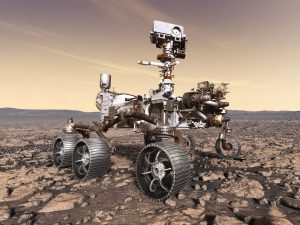
Exciting times as Mars 2020 Rover Perseverance is getting ready to set off on a life-seeking mission, but it marks the beginning of so much more! The Mars 2020 mission is actually the first of a multi-mission effort to return samples from Mars to Earth. That interplanetary round-trip campaign is a precursor for future round-trip crew-carrying spacecraft that will take humans back and forth between Earth and Mars over several missions, ultimately leading to a sustained human presence on the surface of the red planet!
The returned samples that Perseverance collects will be critical for high-priority scientific investigations about microbial life, but will also allow human-mission planners to understand the mechanical properties of the Martian dust, dirt, rocks, and minerals (the “regolith”) – that is, how abrasive they are, their oxidizing potential, particle size and shape, etc. That information will teach us about potential human-health hazards: toxicity, respiratory issues, and potential biohazards of any existing microbial life on Mars etc. These data will help mission planners design strategies to safeguard Mars explorers. The analysis of minerals in the returned samples may also have a direct impact on understanding what natural mineral resources are potentially available for future human use on Mars.
Beyond kicking off the Mars sample return campaign, Perseverance will gather mission-enabling knowledge critical to every phase of humanity’s own future round-trip voyages to Mars: getting safely to the Martian surface, living and working on Mars, and returning home to Earth.
Getting Safely to the Martian Surface
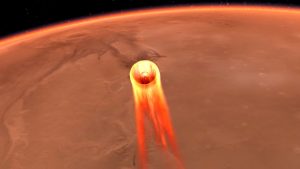
The Mars 2020 aeroshell that protects the rover on its journey carries sensors that will tell us how the spacecraft heats up and performs during entry into the Martian atmosphere. That information will help engineers improve landing designs for the larger crew and cargo landers necessary for human missions. During descent, the rover will demonstrate a new autonomous guidance system called Terrain Relative Navigation (TRN). This hazard-avoidance system may join beacons and other technologies that support landing large cargo in advance of humans, as well as eventual piloted landings by crewed vehicles.
Living and Working on Mars
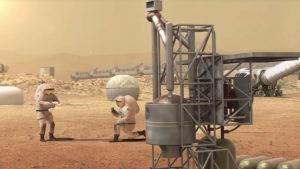
Mars is an extreme environment, but Perseverance is going to make the most of it. The rover carries a special “lung” that will produce oxygen from Mars’ carbon-dioxide atmosphere. It will be the very first demonstration of how to process natural resources on Mars for human use. Large quantities of oxygen will be needed to produce propellant (“rocket fuel”) for astronauts’ return trip home to Earth, as well as to provide back-up oxygen supplies for breathable air.
The oxygen-generating instrument will also monitor how abundant Martian dust in the atmosphere interacts with machinery to improve future engineering designs. In addition, Perseverance’s new weather-monitoring capabilities are specially designed to enhance our understanding of the relationship between dust and weather through the Martian seasons. Learning more about Martian dust will help engineers design better shelters for astronauts, as well as equipment that has to function for long durations on the surface. After all, Mars-bound explorers will want to know their equipment will work for years in the Martian environment.
Once at home on the surface, future human explorers venturing outdoors on Marswalks will need spacesuits that are strong enough to withstand the elements, but flexible enough to move around with agility. Perseverance carries five samples of different space-suit materials to see how each performs in long exposures to radiation and dust in the Martian environment.
As they explore, robotic companions will likely join the crew to enhance their scientific investigations and help keep them safe, just as Perseverance has a helicopter pal named Ingenuity. Like drones here on Earth, Ingenuity will soar overhead, demonstrating how future aerial vehicles could scout out compelling places for humans to explore – or venture into places too steep or too hazardous for people.
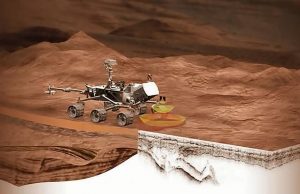
Perseverance also demonstrates the first ground-penetrating radar on the Martian surface. Similar systems will land at a potential human base in advance of people arriving, to look for precious water resources found in subsurface water ice. Just as we can extract valuable resources from the Martian atmosphere, water ice on Mars can be processed to produce hydrogen, another key ingredient of propellant needed for launching back to Earth from Mars.
While Perseverance’s landing site in Jezero Crater is likely too close to the equator for water ice to be present, a future ice-seeking orbiter will be able to calibrate its radar with Perseverance’s results, helping to ensure resources are really there and accessible before humans arrive. Seeing the structure of subsurface rock layers will also ensure that the ground below is stable enough for landing heavy human-class payloads such as a life-supporting habitat and for building a launch pad and other infrastructure needed by human explorers.
Returning to our Home World: Earth
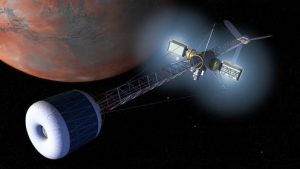
Thanks to the Mars 2020 mission, living and working on Mars will be safer and more comfortable, from habitat design to “walkabouts.” When the first humans are ready to blast off from Mars on their voyage back to Earth, they will use oxygen, hydrogen, and methane fuel that can be traced back to Perseverance’s demonstrations of how to use Martian natural resources. And, just like the samples Perseverance collects, Mars astronauts will launch on a Mars Ascent Vehicle and reunite with a “Mothership” that will carry them safely home. While sending humans to Mars is a complex endeavor, making step-by-step progress through Perseverance and other advances, our human adventure on Mars is closer than ever.
